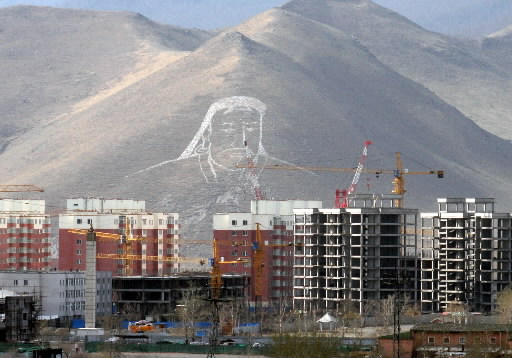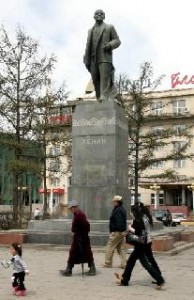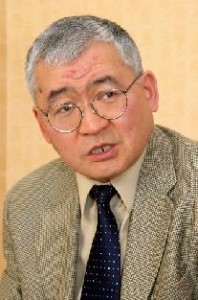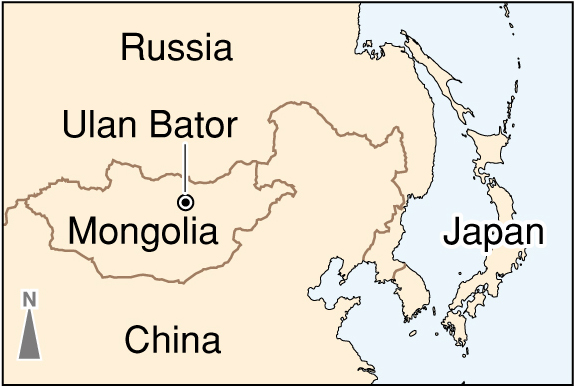Nuclear weapons can be eliminated: Chapter 3, Introduction
Jun. 18, 2009
Chapter 3: Mongolia's challenge
Introduction: Diplomacy moves nuclear weapons states
by Keisuke Yoshihara, Staff Writer
After its democratization, Mongolia, a nation wedged between the nuclear weapons states of Russia and China, concluded a friendship treaty with the two nations, and declared its “nuclear-weapon-free status” at the United Nations General Assembly. At the same time, Mongolia has been seeking balance in its relations with other nations to maintain its national security. In this regard, they have avoided creating an overly close relationship with a “third partner,” such as Japan and the United States, which supported its democratization. The Chugoku Shimbun relates Mongolia’s unique strategy for peace, with which it resolutely strives to remain independent from the intervention of larger powers.
Mongolia strengthens its stance with U.N resolution
Chinggis Khaan (Genghis Khan), the first khan or emperor of the Mongol Empire, watches over downtown Ulaanbaatar, the capital of Mongolia. His face has been depicted in an enormous monument, 240 meters high and 320 meters wide, made of stones collected from 21 provinces nationwide. The monument was erected in 2006 when the nation celebrated the 800th anniversary of its founding.
However, developments within this country over the past 800 years were far from uneventful. Until 1911, when the Chinese Revolution took place, Mongolia had been under the control of China’s Qing Dynasty for over 200 years. Later, the nation became a socialist state during the Cold War era, a “satellite” of the Soviet Union. In the 1960s, the Soviet Union and China became engaged in confrontation. Prior to nuclear testing by China in 1964, the Soviet Union had studied the possibility of attacking China’s nuclear facilities. This example, and others of that period, show that Mongolia was at risk of becoming a site of nuclear devastation. The driving force behind implementing a policy of denuclearization is said to stem from the peril of this time.
Almost two decades have passed since the nation became a democracy. While a statue of Lenin still stands alongside a street, the building of the main post office sports a large billboard advertising cola. The people of Mongolia evidently entrust their wishes of prosperity, stability, and peace to their enormous hero, Chinggis Khaan.
Mongolia declared its territory a “nuclear-weapon-free zone” in 1992, after its democratization. The international community recognized this status in a resolution adopted by the United Nations General Assembly in 1998. Mongolia then enacted a law in 2000 which prohibits the development, manufacture, or possession of nuclear weapons, as well as the transit of nuclear-related components and other materials through Mongolian territory. Using all available means, the nation is determined to enhance the effectiveness of its denuclearization policy.
Tsutomu Ishiguri, 61, professor at Kyoto University of Foreign Studies, provided support to Mongolia’s nuclear-weapon-free zone policy when he served as director of the U.N. Regional Center for Peace and Disarmament in Asia and the Pacific. Mr. Ishiguri appreciates Mongolia’s achievements, remarking, “Nations typically end their efforts after declaring their policies. But Mongolia put it on the ‘agenda’ of the international community by having the United Nations General Assembly adopt the declaration. This shows Mongolia’s exceptional diplomatic efforts, which are highly commendable. It is a good example of a nation utilizing the United Nations in an effective manner.”
On April 27 and 28, 2009, delegations from the four nuclear-weapon-free zones (NWFZ), including Latin America and the South Pacific, gathered in Ulaanbaatar. The participants discussed what actions they should pursue in connection with the Nuclear Non-proliferation Treaty (NPT) Review Conference to be held next year. The Mongolian government took the initiative of holding this international conference.
The land area of Mongolia is almost four times as big as that of Japan. However, the population is only about 2.7 million, slightly less than Hiroshima Prefecture. The courageous and significant challenge taken up by this small nation involves not only influencing the major powers but expanding the network of the nuclear-weapon-free zones.
To date, the number of countries, including Mongolia, that are members of nuclear-weapon-free treaties stands at 65. If the African NWFZ Treaty, which the participating nations have already signed, comes into force, the number will surge to 119. This number would account for 62 percent of the 192 U.N. member states.
Interview with Jargalsaikhany Enkhsaikhan on Mongolia's "nuclear-weapon-free zone" policy
The Chugoku Shimbun interviewed Jargalsaikhany Enkhsaikhan, 58, ambassador to Austria, on Mongolia’s “nuclear-weapon-free zone” policy. Mr. Enkhsaikhan has been spearheading this policy and, as the Permanent Representative of Mongolia to the United Nations, devoted himself to securing the U.N. General Assembly resolution in 1998.
When was the idea of the “nuclear-weapon-free zone” policy conceived?
It was conceived in 1990 when Mongolia became a democratic nation and Soviet troops withdrew from the country. I proposed the policy in 1992 when I was serving as foreign affairs advisor to President Ochirbat and we discussed it within our National Security Council. We reviewed our diplomatic policy with an eye to establishing the sovereignty and national security of Mongolia by building trusting and balanced relations with Russia and China. I felt the idea of a “nuclear-weapon-free zone” would also be compatible with the national interests of both nations.
The spirit of our policy rejects both the nuclear policy of the major powers as well as nuclear proliferation. It is also our wish to maintain neutrality and the non-intervention of all nuclear weapons states. I am not the only one who should be credited with the success of our policy. If the president had consulted with Russia or China in advance, Mongolia could not have declared its policy at the United Nations. That was a big step for our nation to take on its own.
What was the rationale behind Mongolia not only declaring its policy at the United Nations but pursuing the adoption of a resolution at the United Nations General Assembly?
No declaration can guarantee results, since it only asserts a certain stance. To help realize our intention and forestall violations by other countries, we considered recognition by the international community essential.
Did you experience any difficulties having the resolution adopted?
We had discussions with the nuclear weapons states, which weren’t easy. I assume that, at heart, not only Russia and China, but the U.S., too, did not support our policy. If a number of nations establish “single state nuclear-weapon-free zones” (SS-NWFZs), as we did, this creates problems for the nuclear weapons states. For example, the territories of these SS-NWFZs cannot be used to transit nuclear weapons and materials.
In the scenario involving the North East Asia Nuclear-Weapon-Free Zone, you have proposed that each member nation gain its nuclear-weapon-free status on a temporary basis.
First of all, it’s essential to foster trust and create conditions based on fairness. In getting out from under the nuclear umbrella by declaring their nuclear-weapon-free status, the member nations will each preserve their national security from the nuclear weapons states. In line with this process, the member nations should begin their negotiations to establish the North East Asia Nuclear-Weapon-Free Zone Treaty.
What policy should be taken by the Japanese government?
U.S. President Barack Obama declared in Prague that the U.S., as the only nuclear power to have used a nuclear weapon, has a moral responsibility to act. I expect that his stance will enable Japan to work positively on the issue. A number of nations have been pursuing nuclear disarmament and the abolition of nuclear weapons. I hope that the Japanese government will assume a leading role. It is critical to act, rather than simply making proposals.
If the Japanese government acts assertively, the United Nations and the countries seeking to abolish nuclear weapons would surely support Japan’s efforts. I’m not sure how the U.S. would react, but I believe that Russia, China, and South Korea would welcome the move.
Chronology of the denuclearization of Mongolia
March 1990: The People’s Revolutionary Party held its Central Committee General Meeting. It adopted a resolution renouncing one-party control and embarked on reform.
September 1990: The nation transformed to a presidential system. The first president, Ochirbat, was elected.
January 1992: The nation adopted a new constitution which took effect in February. The name of the nation was changed from the Mongolian People’s Republic to Mongolia.
September 1992: President Ochirbat declared the nation a “nuclear-weapon-free zone” at the U.N. General Assembly, stating, “To strengthen disarmament and trust-building in the region and in the world, Mongolia declares its territory a nuclear-weapon-free zone. The nation will be engaged in policy measures to have its status internationally recognized.”
December 1992: The Russian news agency TASS reported that Russian troops stationed in Mongolia had completed their withdrawal.
January 1993: Mongolia concluded its Friendship Treaty with Russia. Russia pledged respect for Mongolia’s policy of non-deployment and a ban on transit through its territory of foreign troops, nuclear weapons, and other military articles.
October 1993: A Chinese Foreign Affairs’ spokesperson indicated that China welcomed and supported Mongolia as a non-nuclear weapon state. The United States confirmed that it would support Mongolia in case the nation was attacked by nuclear weapons and that it would not use or threaten to use nuclear weapons against Mongolia.
November 1993: The United Kingdom expressed comments similar to those of the United States.
January 1994: France confirmed that it would not use or threaten to use nuclear weapons against Mongolia.
April 1994: Mongolia concluded its Friendship Treaty with China. Both nations issued a joint announcement in the press, stating, “China reiterated that it would respect Mongolia’s independence, sovereignty, territorial integrity, and nuclear-weapon-free status.”
October 1996: Mongolia looked into the possibility of obtaining a resolution at the U.N. General Assembly in regard to creating the Central Asia Nuclear-Weapon-Free Zone, which would include Mongolia. But Mongolia abandoned the idea when it did not gain sufficient support due to the fact that the country shared no borders with other participating nations.
April 1997: Mongolia submitted a working paper on its “single state nuclear-weapon-free zone” at the U.N. Disarmament Commission.
December 1998: The U.N. General Assembly adopted, without a vote, the resolution on “Mongolia’s single state nuclear-weapon-free status.”
February 2000: Mongolia adopted the “Law of Mongolia on its nuclear-weapon-free status.” Article 1 stipulates its objective and states: “No nuclear weapons exist on the territory of Mongolia, which constitutes an important factor for ensuring Mongolia’s security.”
October 2000: Five nuclear weapons states issued a joint statement at the First Committee of the U.N. General Assembly and “reaffirmed their pledge of cooperating with Mongolia in implementing the 1998 U.N. General Assembly resolution.” In November, the U.N. General Assembly adopted the resolution.
September 2001: A conference with non-governmental experts held in Sapporo proposed that Mongolia seek to conclude treaties with nuclear weapons states to make Mongolia’s nuclear-weapon-free zone declaration legally binding.
April 2005: A Nuclear-Weapon-Free Zone Treaty conference with the participation of some 90 countries was held in Mexico.
March 2009: Russia, China, and Mongolia held a meeting in Geneva, Switzerland to discuss the draft of a trilateral treaty.
April 2009: The Mongolian government held a Nuclear-Weapon-Free Zone international conference in Ulaanbaatar.
(Originally published on June 1, 2009)
To comment on this article, please click the link below. Comments will be moderated and posted in a timely fashion. Comments may also appear in the Chugoku Shimbun newspaper.











